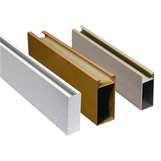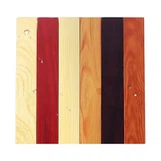As an Aluminum Rectangular Tube supplier, I've had my fair share of experiences dealing with different aluminum alloys. One question that often pops up from customers is about the weldability of these alloys in rectangular tubes. So, let's dive right in and explore what makes each alloy unique when it comes to welding.
6061 Aluminum Alloy
First off, we've got the 6061 aluminum alloy. This one's a real workhorse in the industry. 6061 T6 Aluminum Rectangular Tubing is widely used because of its excellent combination of strength, corrosion resistance, and formability.
When it comes to weldability, 6061 is pretty good. It can be welded using various methods like TIG (Tungsten Inert Gas) and MIG (Metal Inert Gas) welding. TIG welding is often preferred for 6061 because it allows for better control of the heat input. This is crucial because aluminum has a high thermal conductivity, which means it can dissipate heat quickly. If the heat input is too high during welding, it can lead to issues like distortion and reduced mechanical properties in the welded area.
One thing to keep in mind when welding 6061 is the presence of magnesium in the alloy. Magnesium can react with oxygen in the air to form magnesium oxide, which can cause porosity in the weld. To prevent this, it's important to use a shielding gas like argon during welding. Also, proper cleaning of the tube surface before welding is essential to remove any contaminants that could affect the weld quality.
6063 Aluminum Alloy
Next, let's talk about the 6063 aluminum alloy. 6063 T52 Aluminum Square Tube is known for its excellent surface finish and extrudability. It's often used in architectural applications where appearance matters.
In terms of weldability, 6063 is also quite good. Similar to 6061, it can be welded using TIG and MIG methods. However, 6063 has a lower magnesium content compared to 6061, which means it's less prone to porosity issues during welding. This makes it a bit easier to weld, especially for those who are new to welding aluminum.
The heat input during welding 6063 should also be carefully controlled. Since it's often used in applications where the appearance is important, any distortion or discoloration caused by excessive heat can be a problem. Using a lower heat input and proper welding techniques can help achieve a clean and aesthetically pleasing weld.
Other Aluminum Alloys
There are also other aluminum alloys used in rectangular tubes, such as 5052 and 7075. The 5052 alloy is known for its high corrosion resistance and good formability. It's commonly used in marine applications. When it comes to welding, 5052 can be welded using TIG and MIG methods. However, it has a relatively high magnesium content, so the same precautions regarding porosity prevention need to be taken.
The 7075 alloy, on the other hand, is one of the strongest aluminum alloys. It's often used in aerospace applications where high strength is required. But here's the catch - 7075 has relatively poor weldability. The high copper content in 7075 makes it prone to cracking during welding. Special welding techniques and filler materials are often required to weld 7075 successfully.


Factors Affecting Weldability
Several factors can affect the weldability of aluminum alloys in rectangular tubes. One of the most important factors is the alloy composition. As we've seen, the presence of elements like magnesium and copper can have a significant impact on the weld quality.
The heat treatment condition of the tube also matters. For example, a tube in the T6 temper (like Rectangle 6061 Aluminium Tubes) has been heat-treated to achieve a certain level of strength. Welding can alter the heat treatment condition in the welded area, which may affect the mechanical properties of the tube.
The thickness of the tube is another factor. Thicker tubes require more heat input during welding, which can increase the risk of distortion and other welding defects. Proper preheating and post-weld heat treatment may be necessary for thicker tubes to ensure a good weld.
Tips for Welding Aluminum Rectangular Tubes
If you're planning to weld aluminum rectangular tubes, here are some tips to keep in mind:
- Clean the tube surface: Before welding, make sure to clean the tube surface thoroughly to remove any dirt, oil, or oxide layer. This can be done using a wire brush or a suitable cleaning agent.
- Use the right shielding gas: As mentioned earlier, using a shielding gas like argon is essential to prevent oxidation and porosity during welding.
- Control the heat input: Use the appropriate welding parameters to control the heat input. This can help prevent distortion and ensure good weld quality.
- Choose the right filler material: Different aluminum alloys may require different filler materials. Make sure to choose the filler material that is compatible with the base alloy.
Conclusion
In conclusion, the weldability of different aluminum alloys in rectangular tubes varies depending on the alloy composition, heat treatment condition, and tube thickness. Alloys like 6061 and 6063 are generally easy to weld and are widely used in various applications. Other alloys like 7075 require more specialized welding techniques.
If you're in the market for aluminum rectangular tubes and have questions about weldability or any other aspect, don't hesitate to reach out. We're here to help you choose the right alloy and provide you with high-quality products. Whether you're working on a small DIY project or a large industrial application, we've got the right aluminum rectangular tubes for you. Contact us today to start your procurement process and discuss your specific requirements.
References
- Aluminum Association. Aluminum Standards and Data.
- Welding Handbook, American Welding Society.




